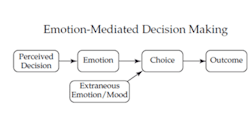Historically, organizations have made substantial investments in the anticipation and elimination of incidents, specifically in the areas of prevention, process and systems improvement. Much of this investment is – and will continue to be – rooted in the foundational elements, philosophies and psychology of behavior-based safety.
Organizations frequently attempt to identify effective interventions to improve safety performance, including tools, processes and messages to employees. However, gaps and residual injuries often remain after such solutions are put in place.
Company executives are wise to make behavior-based safety the foundation for their safety management systems, but to really improve safety performance, organizations must understand how employees make decisions and teach them how to make better decisions to lower their risk.
Decision-Making and What Drives It
It is estimated that people make tens of thousands of decisions daily, many of which are subconscious (Daum, 2012). Given the complexity of daily life, and the thousands of decisions that are made by individuals, how are decisions that often are followed by subconscious actions deliberated, selected and acted on, and what impact do these decisions have on safety and on safety cultures within companies?
To change or improve subconscious decision-making, it is important to understand those decisions that often are based in simple behavioral psychology. Thorndike and Skinner found that actions that were positively reinforced were likely to create a reoccurrence of the action, and as Pavlov found, the anticipation of that reward leads to a predictable response (Loewenstein, Vohs, & Baumeister, 2012).
This anticipation of the reward becomes a cyclical reinforcement of the decision. Not only is the behavior reinforced each time the behavior is exhibited, but it also becomes a factor in the decision-making.
Historically, incident prevention systems have focused on the anticipation and elimination of incidents and primarily centered on the concepts of behavior-based safety (BBS) modeled on the decision-making process discussed above. These BBS systems rely on elements that are essential in any safety system, including the cognitive and behavioral domains. These essential components ensure that rules and procedures are in place, are clearly communicated and are coupled with consequences for adhering to or violating the rules.
But even with decades of safety planning, training and systems, companies still experience incidents. Often these organizations are defined as being stuck on a “plateau,” unable to continue their safety improvement. One reason for this plateau is that organizations experience difficulty managing the unexpected or unobserved circumstances that are out of the ordinary or outside of the standardized processes, procedures or general work life.
New Thinking about Subconscious Decisions
Consider the decisions that are made by people every day while shopping, driving, working or just walking down a busy street. For most of the decisions made in these situations, we go through a ver short conscious period of deliberation. Many, if not the majority, of these everyday decisions are made at varying levels of consciousness, or sub-consciousness. (Sahakian & Labuzetta 2013, p. 5). Some estimate that while humans make up to 35,000 decisions a day (Daum, 2012), some decisions are deliberate and thoughtful, but the vast majority are made at varying levels of sub-consciousness.
For example, University of Texas researchers found that we use an average of 16,000 words a day (Swaminathan, 2007). Most of these words are selected subconsciously, but selected nonetheless (Mehl, Vazire, Ramírez-Esparza, Slatcher, Pennebakerj, 2007). Subconscious decision-making also is a large factor when driving a motor vehicle. OSHA reports that “drivers make more than 200 decisions during every mile traveled,” so simply driving 20 miles a day adds considerably to the number of decisions made each day.
Given that there are so many decisions being made in a day and that many are being made subconsciously, the logical question is what is guiding those decisions, the largest share of which we cannot remember?
While participating in a summer-long research institute at Russel Sage College, researcher Christopher J. Anderson offered a simple explanation that points the finger at emotions and suggests that emotions provide a circular, sequential and self-reinforcing model of decision guidance. Anderson explains that emotions first “shape” decisions, aid in their implementation and then provide almost immediate feedback on them.
As a decision-maker matures and experiences the emotional feedback or “payoff” of the decision, the emotional feedback is no longer unexpected, but anticipated, and begins to factor in the initial step in “shaping” the decision, as illustrated in the figure below (Loewenstein, Vohs, & Baumeister, 2012).
It is impractical to conclude that behavior-based safety systems are capable of influencing the behaviors of workers every minute of their day. The majority of workers are unable to account for or recall the great majority of daily decisions, many of which can be risk-related (either to self or others). Risk cannot be managed away, and rules, consequences and systems only can provide protection if systems are in place. That protection only is possible if a worker is making rational decisions while performing predictable tasks, in planned environments, with lucidity and a high level of conscious reasoning.
Current thinking around organizational safety requires an approach that addresses the cognitive, behavioral and affective elements of risk-related decision making. When cognitive processes get overloaded, they relegate certain tasks to the subconscious, and actions – not always good ones – soon follow. Without consideration of the affective domain, the emotional drivers for subconscious decision-making cannot be acknowledged and changed, and organizations likely will remain on their safety “plateau,” unable to make further progress toward an effective safety culture.
About the author: Dr. George Haber, Ph.D., is the global director instructional systems at DuPont Sustainable Solutions. He helped develop DuPont’s process known as the Risk Factor to increase awareness of subconscious decision and its impact on a company’s safety management system. For more information, contact DuPont Sustainable Solutions at 877-262-7825.


